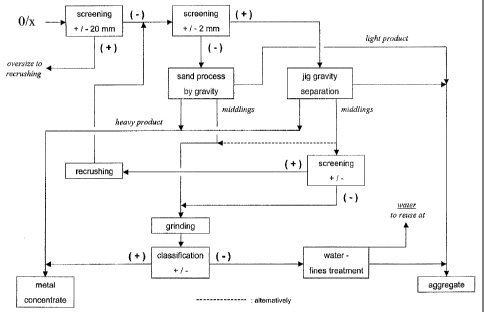Some of the information on this Web page has been provided by external sources. The Government of Canada is not responsible for the accuracy, reliability or currency of the information supplied by external sources. Users wishing to rely upon this information should consult directly with the source of the information. Content provided by external sources is not subject to official languages, privacy and accessibility requirements.
Any discrepancies in the text and image of the Claims and Abstract are due to differing posting times. Text of the Claims and Abstract are posted:
| (12) Patent: | (11) CA 2418020 |
|---|---|
| (54) English Title: | STEEL SLAG PROCESSING JIG SYSTEM |
| (54) French Title: | SYSTEME DE BAC A PISTONNAGE POUR LE TRAITEMENT DE RESIDUS D'ACIER |
| Status: | Deemed expired |
| (51) International Patent Classification (IPC): |
|
|---|---|
| (72) Inventors : |
|
| (73) Owners : |
|
| (71) Applicants : |
|
| (74) Agent: | GOWLING WLG (CANADA) LLP |
| (74) Associate agent: | |
| (45) Issued: | 2011-09-13 |
| (22) Filed Date: | 2003-02-04 |
| (41) Open to Public Inspection: | 2004-08-04 |
| Examination requested: | 2008-02-04 |
| Availability of licence: | N/A |
| (25) Language of filing: | English |
| Patent Cooperation Treaty (PCT): | No |
|---|
| (30) Application Priority Data: | None |
|---|
The present invention relates to a method for separating steel slag into a
metal
concentrate fraction and an aggregate fraction by (i) crushing the slag and
screening to
recover slag having a diameter of less than about 20 mm and (ii) further
separating the
recovered slag in a first fraction of more than about 2 mm and a second
fraction of less
than about 2 mm. The first fraction is separated into a metal concentrate
fraction, an
aggregate fraction a coarse middlings fraction and a fine middlings fraction.
The second
fraction is separated into a metal concentrate fraction, an aggregate
fraction, and a
middlings fraction. The coarse middlings of the first fraction are recrushed
and fed into
step ii), whereas the middlings from the second fraction and the fine
middlings from the
first fraction are ground and separated into a metal concentrate fraction and
an
aggregate fraction.
La présente invention se rapporte à une méthode de séparation des scories de l'acier en une fraction de concentré de métal et en une fraction d'agrégat. Voici le mode opératoire. i) Broyage des scories et criblage pour récupérer les scories dont le diamètre est inférieur à environ 20 mm; et ii) séparation ultérieure des scories récupérées d'une première fraction, de plus de 2 mm et d'une seconde fraction, de moins de 2 mm. La première fraction est séparée en une fraction de concentré de métal, une fraction d'agrégat, une fraction moyenne brute et une faction moyenne fine. La seconde fraction est séparée en une fraction de concentré de métal, une fraction d'agrégat et une fraction moyenne. La fraction moyenne brute de la première fraction est broyée de nouveau et appliquée selon l'étape ii), tandis que la fraction moyenne de la seconde fraction et de la fraction moyenne fine provenant de la première fraction est moulue et séparée en une fraction de concentré de métal et en une fraction d'agrégat.
Note: Claims are shown in the official language in which they were submitted.
Note: Descriptions are shown in the official language in which they were submitted.

For a clearer understanding of the status of the application/patent presented on this page, the site Disclaimer , as well as the definitions for Patent , Administrative Status , Maintenance Fee and Payment History should be consulted.
| Title | Date |
|---|---|
| Forecasted Issue Date | 2011-09-13 |
| (22) Filed | 2003-02-04 |
| (41) Open to Public Inspection | 2004-08-04 |
| Examination Requested | 2008-02-04 |
| (45) Issued | 2011-09-13 |
| Deemed Expired | 2020-02-04 |
There is no abandonment history.
| Fee Type | Anniversary Year | Due Date | Amount Paid | Paid Date |
|---|---|---|---|---|
| Application Fee | $150.00 | 2003-02-04 | ||
| Registration of a document - section 124 | $100.00 | 2003-10-31 | ||
| Maintenance Fee - Application - New Act | 2 | 2005-02-04 | $50.00 | 2005-01-21 |
| Maintenance Fee - Application - New Act | 3 | 2006-02-06 | $50.00 | 2005-11-29 |
| Maintenance Fee - Application - New Act | 4 | 2007-02-05 | $50.00 | 2007-01-09 |
| Maintenance Fee - Application - New Act | 5 | 2008-02-04 | $100.00 | 2008-01-29 |
| Request for Examination | $400.00 | 2008-02-04 | ||
| Maintenance Fee - Application - New Act | 6 | 2009-02-04 | $100.00 | 2009-02-03 |
| Maintenance Fee - Application - New Act | 7 | 2010-02-04 | $100.00 | 2010-01-27 |
| Maintenance Fee - Application - New Act | 8 | 2011-02-04 | $100.00 | 2011-02-01 |
| Final Fee | $150.00 | 2011-06-27 | ||
| Maintenance Fee - Patent - New Act | 9 | 2012-02-06 | $100.00 | 2012-01-24 |
| Maintenance Fee - Patent - New Act | 10 | 2013-02-04 | $125.00 | 2012-12-03 |
| Maintenance Fee - Patent - New Act | 11 | 2014-02-04 | $125.00 | 2014-01-07 |
| Maintenance Fee - Patent - New Act | 12 | 2015-02-04 | $125.00 | 2014-11-26 |
| Maintenance Fee - Patent - New Act | 13 | 2016-02-04 | $125.00 | 2015-11-10 |
| Maintenance Fee - Patent - New Act | 14 | 2017-02-06 | $125.00 | 2016-11-14 |
| Maintenance Fee - Patent - New Act | 15 | 2018-02-05 | $225.00 | 2018-01-15 |
Note: Records showing the ownership history in alphabetical order.
| Current Owners on Record |
|---|
| TROCAN INC. |
| Past Owners on Record |
|---|
| BRODEUR, JEAN |